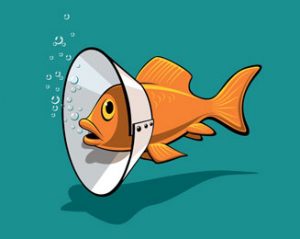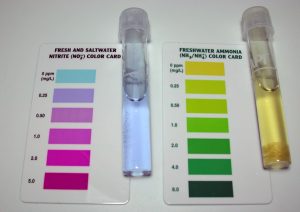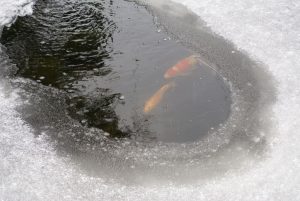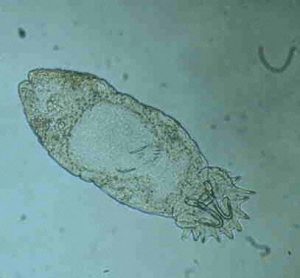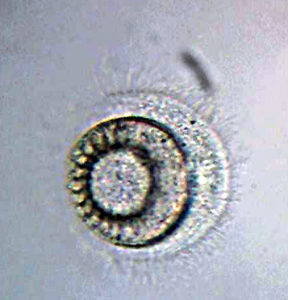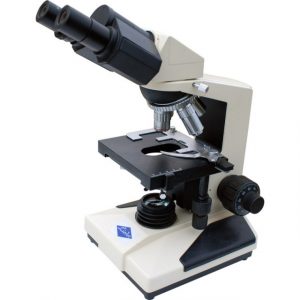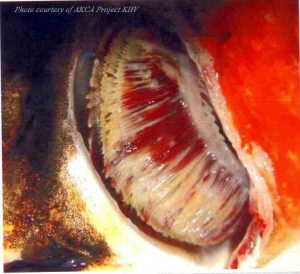Quarantine Procedures
In this article I will attempt to give you a basic understanding of the relationship between your Koi and Goldfish, and the many pathogens or possible pathogens that live on and amongst them. Pathogens like bacteria, parasites and viruses, are a constant threat to the health and well being of your slimy friends if not managed properly. I say “managed” because most of these pathogens inhabit your fish or your pond water at all time. Even fish that have been fully treated with all the types of treatments normally utilized in the industry can still carry a small percentage of these pathogens. It is almost impossible to completely eliminate them from the water or the fish. Some of them live deep within the fish where most treatments cannot touch them, and given the right stressors, can come out from hiding and go to work attacking your fish. It is our job to keep those stress factors to a minimum at least. Understand as well that some of these critters that can hurt our fish are actually needed on the fish and in the water at times, and they are a natural part of the eco system there. It is only when they get out of hand or become overpopulated that they usually hurt the fish. You should also realize that what I am about to write might sound very a little overwhelming or even discouraging and will falsely attempt to make you paranoid and keep you from truly enjoying your fish and your pond. You must learn how to keep all this in perspective and realize that it is your duty to learn as much about fish health and disease as possible, but at the same time not let it be all consuming. I have had some customers over the years that once they learn about these pathogens they become obsessed with them. They watch over their ponds and fish to a degree that all they do is worry and look for problems and /or symptoms. There is no way that that can be enjoyable and relaxing as this hobby is intended to be. So, keep this in mind and don’t become one of those paranoid hobbyists that forget to enjoy their pond and fish.
Know that the vast majority of our customers DO NOT quarantine new fish they buy from us and experience no problems. However, we always recommend following at least some quarantine procedure when adding new fish.
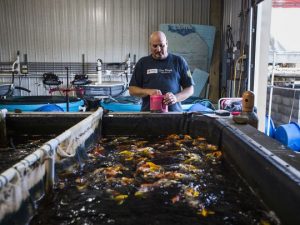
Understand now that some of which I have written would be considered “ultimate” fish keeping! Not everyone can or will do all of these things. Well, that’s fine, and perfectly understandable. There is this “ultimate” fish keeping, and there is a combination of that, and your reality. There are some basic and absolute requirements of fish husbandry that we all need to address and understand, and then there is what I call “bubble boy” fish husbandry. What I mean by this is that most times it is virtually impossible in your real world to protect your fish 100%, from all the possible pathogens living on the fish and in the water. That is…. unless we kept them in a totally protected biosecure “bubble” so to speak. There are many types of costly filters, treatments, and other things we can use to make our ponds practically sterile, but in most cases this is not reality for the average person. We can’t keep the fish in a lab-grade clean room that is 100% protected and isolated, and enjoy them at the same time. However, we can do the research and learn as much as we can to reasonably protect them from these possible attackers. Hopefully what I have written will help you to decide your reality and keep your fish as safe and healthy as reasonably possible. It is up to you to draw your own line as to the degree you wish to take it, but at the same time realizing that you have a responsibility to take care of this living creature to the best of your ability.
Believe me when I say that all that is known about fish health was learned from someone inadvertently killing his or her fish, then digging deeper to determine the actual cause. Prevention and/or the early detection of possible problems are the keys to success. We have all learned the hard way at times, but there is no better teacher then those experiences. Once you have a basic understanding of water quality and its effects on fish, you will have gone a long way in the prevention of any potential health problems. Another key factor in good fish husbandry is the early detection of problems. This is accomplished through the visual interpretation of the fish’s body language. They will always give you some sort of sign of impending ill health. If caught early enough, most problems are easily remedied. Refer to the page entitled “Koi Symptom Diagnosis” for a more complete listing of the signs of poor health. That section gives you a detailed description of how to detect possible problems in the early stages, be it from poor water quality and/or parasites and such by teaching you ways to read the fish’s body language.
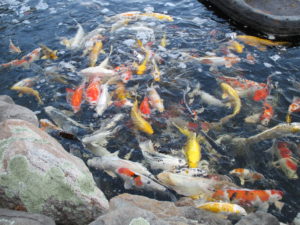
Quarantine Procedures for Hobbyists
The following is basic quarantine information intended for the average hobbyist. We will discuss professional or industrial-scale quarantine later on in this article.
The Immune System
As mentioned above, it is important for you to understand that ALL fish can carry parasites and possibly even latent, low level bacterial and viral infections. They can and will act as transmitters and possibly contaminate each other, but may not acquire the problem themselves. Whether or not a fish becomes ill or dies because of it is directly related to things such as stress factors, the integrity of the individual immune system, water quality, genetics, nutrition, age, environmental factors, etc. If a fish carries only low levels of infection, it is possible that they will build immunities to that particular disease or pathogen, and never show any symptoms or become ill because of them.
As an example of acquiring immunity to disease, when we as children receive immunizations for things such as chicken pox, we are actually receiving minute doses of the disease. In this manner our immune system can create antibodies over time and keep the attacking virus at bay due to its low levels. If we were to get the disease, it is rare to get it again because our bodies have learned what antibodies are required and attack the virus as soon as it attempts to become active again. However, in the actual case of chicken pox, in reality we can get the disease again later in life in the form of shingles. The right set of stress factors can cause this second outbreak to occur. If this were to happen, we can again become carriers and spread it to others during this second outbreak. These immunities and antibodies stay with most of us for most of our lives, however, and getting shingles is only slightly possible.
Another example of our immune systems at work would be the fact that most people come into contact with cold viruses on a daily basis, but most of us do not constantly have or acquire colds that frequently. This is primarily due to the fact that our individual immune systems produce antibodies to keep the virus at bay. It is only when our immune system is impaired due to some stress factor and/or set of circumstances that the cold virus can overcome us in our weakened state. The same biological concept holds true with fish.
Also the immune system in Koi and goldfish is very water temperature related. The optimum water temperature range to house Koi or goldfish is from 70 to 80 degrees Fahrenheit. At these temperatures the immune system is working at its peak performance. This is why in many cases the occurrences of sick fish happens in colder water temperatures when the fishes immune system is in a weakened state.
The immune system of fish begins with the layers of skin and scales which act as physical barriers to stop or detour any potential invaders from penetrating into the organs or bloodstream. This is why it is vital to quickly address any physical breaks in this skin due to injury. Also, fish have an outer coating of slime which plays a major role in protecting the fish from disease. This slime coat houses some very important immune related bactericides and fungicides which are constantly attacking any potential invaders. For this reason it is very important to avoid degrading this slime layer. Poor netting or handing of the fish, as well as poor water quality are the top culprits of disturbing this delicate layer. Never handle fish with dry hands or dry nets, as this will remove the slime very easily. If you must handle the fish, make sure your hands and nets are wet. Much less of the coating will be damaged this way. Try to use a netting material that is made from a soft, non-abrasive material as well.
As stated, poor water quality is usually the biggest factor to the detriment of the slime coat. Things such as low pH (below 7 ppm), or any amounts of ammonia and nitrite are just a few considerations. I CANNOT STRESS ENOUGH THAT MAINTAINING GOOD WATER QUALITY IS THE HEART AND SOUL OF FISH HEALTH. If you haven’t already, please read the article entitled “The Science of Water” for more details.
Currently, throughout the world, there have been outbreaks of some very serious viruses. Most of these are temperature oriented and only show outward signs in specific temperature ranges. The two most serious are KHV (Koi Herpes Virus) and SVC (Spring Viremia of Carp). These can be deadly to Koi and can cause 100% mortality in the fish population of the infected system. To date there is no cure for these two viral infections, but losses can be reduced by changing the water temperature to a range above the tolerance level of either virus, and treating any secondary pathogens that may show up as a result. However, I do not condone this action as these fish would then be carriers that could infect other naïve fish. It is my opinion that any fish struck with either of these viruses be euthanized to eliminate the risk of further spreading of it.
As stated, these virus outbreaks tend to be very water temperature dependent in most but not all cases. SVC usually shows itself in the spring at water temperatures between 50 and 68 degrees F. KHV usually shows itself in the spring or fall in water temperatures in the 70’s and especially from 72 to 78 degrees F. Both KHV and SVC are highly contagious and should be officially diagnosed by a qualified lab. We will discuss these viruses in more detail in future articles, as they are currently (2009), a very serious threat to our Koi. This is also the reason you need to be very careful where you buy your fish from. There are many comprehensive and strict quarantine protocols that must be done by the retailer/dealer/breeder prior to any fish being sold to the public. Unfortunately, only a small percentage of these commercial operations have these protocols in place. For these reasons as well, you should absolutely avoid getting any fish from ANY of the large chain- type superstores or pet stores, as NONE of those places do what is required. Wherever you do end up getting your fish, find out first what they do to help assure you get healthy, disease-free fish.
Several factors such as water quality, temperature, fish stocking levels, and slime coat integrity will affect a fish’s ability to ward off disease and parasites.
Parasites – A BIG Reason to Quarantine
As previously discussed, all bodies of water have naturally occurring parasites/pathogens, which will eventually end up in and on the fish that live there. As a matter of fact, the life cycle of many of these parasites relies on utilizing the fish as a host in order to survive and reproduce. Most of these parasites are microscopic and not visible to the human eye, although some parasites such as fish lice (Argulus) and anchor worms (Lernea) are visible. We will address most of these parasites, both visible and non-visible, at a later date, but some other common microscopic types include Trichodina, Costia, Chilodonella, Gill Flukes, Body Flukes, Eye Flukes, Ich, Oodinium and many more which are less common.
When a fish is born in a given body of water, its immune system and slime coat immediately go to work on attacking and controlling the particular parasites and pathogens that live in that particular body of water. Even before they were born their parents have passed down certain immunities already. It is important as well to understand that not all waters are alike in their population or type of pathogens. So, let’s say a particular fish is born into or came from a body of water whose prevalent parasitic residents are primarily Trichodina and Costia. As long as the population of these parasites is not overwhelming, with good water quality that fish will more than likely be able to keep the numbers at an acceptable and manageable level with no ill effects.
A good example to help you better understand the relationship between the fish and these parasites would be to look at the water we drink. Say you were born and raised in the United States and decided to travel to another country, for example, Mexico. What is the number one rule? DON’T DRINK THE WATER! Why? Because your body is accustomed to the parasites and bacteria that inhabit your water at home and over the years you have built up certain tolerances to these otherwise potentially nasty bugs. When you travel to foreign lands, the water there has different parameters of these pathogens as well as possibly new ones that your body has never come across. When you ingest these new pathogens, you get sick! It is not so much that the water is “bad”, but more the presence of these “foreign” parasites and bacteria, which your body can’t yet tolerate or manage. If you stayed in that county for fair amount of time and drank small quantities of that water on a regular basis, you would eventually build the needed tolerances and be able to drink it with no ill effects. That is why the locals don’t get sick.
Now, fish react the same way. If you introduce new parasites into the water by the introduction of new fish or even plants and other aquatic critters, there is a good chance that your fish could become ill or die. Yes, I said plants. They too can carry these pathogens, and if not properly treated prior to their introduction into your pond, they could cause your fish problems. The introduction of turtles, snails, and virtually any aquatic life form can have the same effect. This is also why it is very important to quarantine and possibly treat, if needed, all new fish and plants before introducing them to the pond.
Flukes (left) and trichodina (right) are some of the more common parasites affecting Koi
Diversification
Now that I have frightened you, let’s stop here a second and discuss this life form diversification in ponds. I personally like and advocate diversification in my ponds. After all, who really wants to have just fish? I feel plants as well as certain other aquatic creatures add to my enjoyment as well as to the natural cycles, and therefore I want it all. However, I will take the extra precautions needed to assure the health of the fish as much as possible. Let me warn you now though, there are people who whole-heartedly disagree with this mentality of having other critters, and for good reason.
There is no doubt that with any aquatic life form you add to your pond, you are also increasing the risk of contamination and the introduction of foreign parasites and disease. It is totally up to you to weigh the added risks as compared to the added enjoyment you will receive. The amount of added risk totally depends on your knowledge of each new species and the possible preventative treatments that may be required before their addition to the pond. The more diversification you want, the more knowledge you must have. Also in direct correlation with the amount of risk these additions may bring with them are many other variables such as overcrowding, environmental issues, water quality, weather, and many more factors too numerous to mention that can increase the likelyhood of contamination.
Let me also state that if I owned the very expensive, show grade Koi, which cost hundreds or even thousands of dollars each, I would not recommend the addition of anything! This includes plants, rocks or any other aquatic life form! The risk is too great due to the expense of those fish. Let me also add that I would house these fish in a separate pond solely designed and maintained for these high dollar beauties. As you can guess, these ponds would be high dollar as well in many cases. Not all of us can afford these things, and this is why there are varied levels of fish keeping techniques.
Stress and Fish Health
Stress for fish comes in many forms, and next to poor water quality, stress is the number one contributing factor when it comes to fish sickness and disease. As mentioned earlier, water quality degradation, overcrowding, sudden water temperature fluctuations, sudden pH fluctuations, abrupt weather changes, predation attempts, transporting of new fish, handling, nutritional deficiencies, and any sudden changes in the chemical makeup of the water, are just some of the contributing stressors which can affect the health of your fish.
When a fish is stressed due to one of these factors, there are actual chemical reactions in its body which release substances such as adrenalin and cortisol which can directly and indirectly inhibit the fish’s immune system responsiveness. In nature, a fish’s environment is fairly stable as compared to our small ponds or aquariums; therefore, there are far fewer stress-related problems. We need to constantly strive to eliminate any of the above-mentioned stressors and keep our small bodies of water as stable as possible. The smaller the system, the harder this is to do.
As stated earlier, even a fish that has been treated recently and completely for all the common pathogens, the stress of shipping and a new environment can open the door for the pathogens that are remaining on the fish. If you throw in poor water quality or housing the new fish with existing fish, well… that is just a bomb waiting to go off! This is why it is so critical to quarantine all new fish, prior to their release into their permanent home. As mention previously, we will discuss proper quarantine in the article entitled “Treatments and Quarantine Procedures”.

Adding Plants to Your Pond
With the above in mind, it is very important that in the case of adding plants that they be treated prior to their introduction into the pond. There are many commercial treatments which can accomplish this, but I prefer to use potassium permanganate or 37% Formalin. In the case of Formalin, which is more readily available, simply put the plants in a container of water and add the appropriate amount of Formalin (3cc per every ten gallons of water) and leave them in this solution from 3-5 hours. They now should be pathogen free and can be introduced into the pond. DO NOT ADD THE WATER THEY WHERE SOAKING IN TO THE POND. DISCARD IT IN AN APPROPRIATE WASTE DRAIN.
Quarantining New Fish
As you should be aware by now, it is very important to quarantine all new fish before adding them to the general population of your pond or aquarium. Basically reiterated from above, the fish currently living in your pond, as well as the pond water itself, potentially house a certain type and quantity of parasite and or bacterial strains. Your existing fish’s immune system is capable of keeping these under control due to the tolerances acquired over time. When you add new fish without quarantining, you could be introducing new pathogens, which your existing fish haven’t built immunities to. This could cause health problems for your existing fish. At the same time, the new fish could not be prepared for the pathogens currently living in your pond and on your existing fish, and they too could become sick and possibly die.
I recommend quarantining all new arrivals, but if for whatever reason you choose not , then it is a vital for you to purchase ALL your fish from the same reputable source. Make sure you ask them if they quarantine the fish, for how long, and what types of treatments are utilized. Also ask if they use a microscope to identify any parasites BEFORE and AFTER quarantine. If they do not utilize a microscope, then they too are taking risks of the quarantine treatments not being effective for a multitude of reasons, and I would not purchase fish from them. The only proof of successful quarantine is the use of a microscope, and this is only referring to parasites. Most places do not have the labs needed to culture bacteria or viral strains, so these are still a potential risk. Here at the farm we periodically send fish out for random testing.
Proper Acclimation
To assure the health of your new fish, it is vital to properly acclimate them to the body of water in which you are releasing them. The most important element of acclimation is temperature compatibility between the water they are shipped in and the water they are released in. If the fish have been in the bags for less than four hours, follow the steps outlined in Temperature Acclimation. If they have been in the bags for more than four hours and appear distressed in any way, AND THE TEMPERATURE DIFFERENCE IS LESS THAN TEN DEGREES between the bags and the tank or pond, you could consider releasing them immediately. If they do not appear distressed, or the temperature difference is greater than ten degrees, then follow the temperature acclimation procedures below. It is critical for you to have checked the water quality in the tank or pond PRIOR to releasing them. Especially check the pH, temperature, ammonia, and nitrite. The pH should be between 7 and 9, and you should have ZERO ammonia or nitrite.
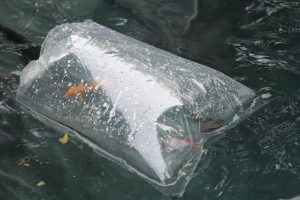
Temperature Acclimation
If the fish appear to be OK in the bags upon arrival home, promptly float the shipping bag, with the fish inside, in the pond or aquarium. Your goal here is to get the temperature in the bag exactly the same as in the pond or aquarium. This will take anywhere from 15 minutes to one-half hour, depending on the temperature difference between the two. If you are putting the fish outdoors, make sure you do not float them in direct sunlight. Put something over the floating bag to shade the fish. Once you are sure the temperature in the bag is exactly the same as the pond or aquarium, or at minimum with five degrees, you should pour the fish into an appropriate container. Once in that container, use a net or likewise to release them to your tank or pond. I prefer to use my hands, but that can be difficult for the inexperienced hobbyists. NEVER PUT THE SHIPPING WATER INTO YOUR TANK OR POND.
Chemical Acclimation
In the past, myself, as well as most of the industry recommended that you gradually mix pond or tank water to the shipping bag to chemically acclimate the fish to the new water. After some research, as well as my own experiments, it is no longer suggested to mix pond or tank water to the shipping bags for any reason.
In you recall from previous articles on water quality, ammonia becomes more toxic as the pH rises above seven. Well, when a fish is in the shipping bags, especially for more than four hours, carbon dioxide builds up as a byproduct of their respiration. This carbon dioxide when mixed in the water changes to carbonic acid, thus lowering the pH. Also, ammonia is rapidly rising due to the respiration, but it is not as toxic or harmful to the fish due to the lowered pH. The pH in shipping bags can commonly drop to five or six because of this reaction, so even though the ammonia can exceed ten ppm, it is not very harmful to the fish because it is in the form of ammonium at these pH levels. You must realize, however, that fish cannot be housed permanently in these low pH levels. It is the worse of two evils though.
Now, as soon as you open the bag, you are releasing the carbon dioxide from the bag; therefore, the pH will rise very quickly. When the pH rises, the ammonia in the bag becomes instantly more toxic. The same holds true if you add pond or tank water to the bag. If the pH of your tank or pond is where it should be, (7 to 8.5) then by adding this water to the bag you are also quickly raising the pH, thus causing the ammonia to become toxic. If the fish are then left in the bag for a longer time, the ammonia can harm them. Therefore, do not add pond or tank water to the shipping bag. When opened, simply release the fish to their new home, but do not dump the water from the bag into the pond or tank.
To summarize, if the fish have been in the bags for less than four hours, float the bag to get the temperature to within five degrees of your tank or pond. Then release them without dumping the bag water in the tank or pond. If they have been in the bag for four hours or more and appear distressed, and the temperature in the bag is less than ten degrees different, it is better to release them as soon as possible rather than leave them in the deteriorated bag water. If the temperature difference is more than ten degrees, float them only enough time to get it to within ten degrees, and release them.
Other Tips and Suggestions
- ALL NEW FISH SHOULD BE QUARANTINED IN A SEPARATE FACILITY FOR A PERIOD OF THREE TO
SEVEN WEEKS BEFORE INTRODUCTION TO YOUR POND OR AQUARIUM. You can read the details for a proper Qt in the article “Koi Treatments & Qt Procedures” if you haven’t already. - Once you pick up your fish, transporting them for more than an hour in hot weather may require you to keep them cool. Your goal is not really to cool the water, but to keep it from getting hotter. The hotter water gets, the less oxygen it can hold. So for this reason you may need to utilize ice, but not in direct contact with the water in the bag. If needed, put it near the bag to cool the surrounding area, but not directly against the water.
- WARNING: Koi are known for jumping out of new, unfamiliar waters the first 24 hours or so after release, so it is best to cover your pond or aquarium during this time. A secondary method would be to float something such as Styrofoam on the surface to give them a feeling of security as well as to detour any jumping.
Full Scale Quarantine For Professionals
The following is just a few of the protocols of many we utilize here at the farm. This paper is for informational use only, and is not necessarily suggested for hobbyist use, although it may be applied in many hobbyist situations as well. You must realize that a commercial aquaculture operation and a hobbyist pond or quarantine tank are two different worlds of Koi keeping, and what we do, and the degrees to which we do them do not always directly apply to the hobbyist. At times they do however. We have to utilize these extremes here due to overcrowding and other issues associated with intensive aquaculture practices. We are intentionally stressing the fish to a degree as well, to promote any pathogenic outbreaks, and address them while in quarantine and thus assure you get only the healthiest fish possible. Basically, you too can use these protocols, but you need to use good judgment when deciding what to do and how to do it.
It is critical to maintain strict bio-security measures at all times, and throughout any quarantine facility, and/or farm in general. Any fish brought into a facility/farm, or fish directly bred and raised at that facility from individual ponds, must be handled in a way as to not contaminate any existing, segregated, in use, or sterilized system other than the one these fish will be entering. This is especially true of foreign fish brought to any farm/ facility from an outside source. These fish must be handled with the complete assumption that they carry serious and deadly viruses that can and will contaminate other batches in the facility. Therefore, it is of utmost importance that strict bio-security protocols me maintained at ALL times. This is also critical if any notifiable pathogens/viral symptoms are later discovered during quarantine, as it will aid in the sourcing and isolation of said pathogens. The following protocols will take a minimum of 34 – 48 days per batch of fish.
Quarantining new Arrivals
Upon arrival, the fish bags shall be handled in a way to assure non-contact with anything in this facility other than the system they are to enter. They then shall be floated and acclimated only to tanks designated for foreign fish. If not done prior, test the water while the fish are still in the bags, and make sure that the appropriate parameters are met, including but not limited to a salinity of .1% or one ppt and a temperature of 75 degrees F. This temperature shall be maintained for three weeks, and is considered to be the ultimate range for KHV symptoms to break if present. I will give further details on this later in this writing. The salt is utilized to help boost the slime coat, as well as calm the fish. These are important factors when treating fish. Stress causes chemicals like cortisol to be released, and that can weaken the immune system.
Upon release of the fish into the system, thoroughly inspect each fish separately for signs of injury or illness as you put them into the system. This is one reason I do this by hand with each individual fish. This allows for a thorough inspection of each one for any signs of issues. As well, this is the time I note the condition of their slime coat. Determining slime coat integrity is the most critical step that will help to determine not only when to begin treatments, but which treatments to utilize. Too much slime and some treatments may fail, and too little slime and any (or especially the strong treatments) may burn or irritate the fish’s skin and gills, and even cause shock and death. We will discuss this in detail later.
I initially started out sampling slime coat with a microscope slide cover slip, but now I can do it by feel after all these years. As for the cover slip method, however, I would gently run the cover slip down the side of the fish for a distance of about one to two inches, and then note the amount of slime on it. Be consistent with the distance you cover on the fish when doing this. I find two inches to work best. It is also best to practice on healthy fish to see what a normal slime coat will produce on the cover slip with this method. Also note that Doitsu fish usually have less of a slime coat than scaled fish, so practice on both types. If you have multiple boxes of fish arriving, you can sample one or two from each box. I cannot stress enough how important it is to determine the slime coat integrity prior to any types of treatments beyond low salt solutions. This is the primary reason you hear some folks say that a certain treatment or medication burned or killed their fish, or failed to eliminate the parasites.
Once all the fish are inspected and put into their respective systems, all boxes and bags associated with shipment shall be removed immediately from this facility, and burned in the designated, approved area. Keep the bags, boxes, and any water in left in the bags from coming into contact with any other systems that house different fish. I know this all sounds like overkill, but when it comes to biosecurity and preventing cross-contamination, there is no such thing as overkill. I basically treat the whole situation of quarantine as if anything and everything associated with the new fish is contaminated, so therefore I want it coming into contact with nothing else. Do you know the saying “treated like they have the plague”? Well, that is what you should really do. If the fish are simply fish from the ponds here at the farm, (which is the case most often) the protocol remains the same. However, there will be no bags and boxes involved in these cases. Instead we bring them in the building in tanks, and net them into their prospective systems. The fish from each individual pond should be put in individual systems. This so as not to have fish from multiple ponds in the same tanks. All nets, tubs, buckets, etc. shall be kept from cross contaminating other systems, and shall be immediately disinfected after use.
At this point, fill out that system log statistics, including the source of the fish (breeder, dealer etc.), date released into the system, and any treatment immediately utilized, as well as any noted symptoms or pathogens observed upon release. If they are foreign fish, the exact source/breeder/dealer they came from should be recorded. Make sure not to mix fish from multiple breeders/dealers in the same system. Each source should have their own separate quarantine and equipment. Also note and record all water parameters tested in that system. I would even suggest the hobbyist keep these records as well, and test and record water parameters on a daily basis. Unless emergency treatments are immediately necessary, let the fish remain untreated (other than salt) for a period of one to two days after arrival. I prefer two days of rest if it is possible. During these two days, however, a salt addition of one part per thousand per day can and should be added, starting with the first day, and daily for two days, until a two parts per thousand (.2%) level is reached on the second day. Higher salt concentrations (up to six parts per thousand) may be utilized for certain approved circumstances, but these levels must be achieved with only .1% additions per day. If these higher doses are required, you may need to bring them back down to no higher than .2% prior to certain other treatments that contain Formalin and malachite green combinations. Some folks have speculated that the fish have had bad reactions to the salt and F&MG combination. We will discuss this later as well. It is important to understand, however, that we only go to the higher levels of salt above .2% for specific reasons such as increasing slime coat and to aid with cases of fish with dropsy. (Bulging eyes and/or scales standing out like a pinecone, and/or ulcerations)
Fish should be fed minimally, if at all, during the treatment protocol. I primarily only feed a little just to see if they eat or not. Whether a fish eats or not can be a good indicator of their well-being and health. Sometimes, however, they may simply be too frightened to eat, so it is important to understand this as well. Food that is new to the fish can also cause them not to eat at times. Maintaining good water quality is far more important than feeding, and in many cases here at the farm we are starting with a freshly sterilized system with very little biological activity in the filtration. This is why daily water testing is also critical.
After the appropriate resting period, and no later than the second day after arrival, a microscopy of at least 10% of the fish in that batch shall be done. In some cases where new fish exhibit symptoms of parasites as soon as they arrive, they may need to be treated on the first day, so in these cases the microscopy would have to be immediately upon arrival. As for immediate treatments, this is a little tricky, and not often needed. In most cases you need to let the fish rest from the stress of shipping and a new environment.
When doing the microscopy, each fish of the 10% chosen in each batch will be separately scraped and scoped from multiple areas, and gill snips must also be done and scoped as well. We will discuss microscopy for the hobbyist at a later time. Also in speaking of hobbyist, there are times that you may get fish from a dealer or breeder that has already treated them, and there will be no need for further treatments. Microscopy would verify this. If you do a microscopy and find no parasites, then I would not do any treatments. However, here at the farm (or any farm for that matter) it is rare that any fish coming from the mud ponds do not have any parasites, and therefore at least some of the following treatments protocols will usually be required. Once the microscopy is done, record any pathogens noted in the log for that system. Here at the farm the most common parasites seen are protozoan, and of these Trichodina is the most common. We will see the occasional Chillodonella, Costia, Vorticella, and some others as well, but all of these protozoan type parasites are also killed by the same treatments to follow. The other most common parasites are the Tremetodes, and of these the most prevalent are skin and gill flukes. These require a separate and specific type treatment of their own, and separate and in addition to the protozoan treatments. The third most common type of parasites are the crustacean type, and of these the anchor worm and fish louse are the most common. These as well require a specific and separate type of treatment to do the job. In addition to the above pathogens, there are also fungal issues as well at times. Here at the farm the treatments we use for protozoan parasites will also cover these fungal infections if they are present. So as you can see, we are basically dealing with four types of pathogens that require three different types of treatments, and this does not include bacterial and viral infections. We will discuss those in detail later. For the hobbyist reading this, I would also suggest all three of the treatments listed be utilized as well, when you are “shotgunning” where no microscopy is utilized. You need to cover all the bases for sure if you cannot absolutely identify what (if any) parasites/pathogens they may have. So with the case of no microscopy all three treatment types should be done, as there is simply no one treatment/product that will kill all the types of pathogens that commonly affect out fish. You will find that many products claim that they kill them all, but I can tell you from experience that they do not. As a matter of fact, most of those products that do claim to kill all types of pathogens ironically do not work well on even one type usually. Basically, avoid the aquarium type treatments that are sold in the pet shops, as most are no good at all, and some are even dangerous and harmful to the fish even when used according to the directions. You WILL need to use three products/treatments to do the job on the three most common pathogens, of protozoa, Tremetodes, and crustacean type bugs. Again, this does not include bacterial and viral infections, as those require even another type of treatment. We will discuss those another time, except for a brief discussion on antibiotic food. For now primarily, we will stick with the three most common types of parasites I have listed.
If any minor bacterial infections are suspected initially, we may feed the appropriate antibiotic feed for a period of no less than 10 to 14 days if approved. However, I must say at this point that I am not a big believer in the effectiveness of any antibiotic foods. If you do decide to feed any type of food, be it antibiotic or otherwise, start off with only a small amount to see if they eat it. The last thing you need is leftover food contaminating the system. Once you see them eating it you may increase the amount if need be. If any bacterial infections noted appear serious, then this treatment protocols to follow can be altered to firstly include an antibacterial bath or dip treatment. Depending on the antibacterial treatment utilized, we may or may not immediately continue with the standard parasitic treatment protocol. Bacterial treatments are addressed and treated according to each individual case, and the protocol will vary depending on the pathogen causing the infections. As stated earlier, we will discuss these another time.
Written by John Fornaro, Hanover Koi Farms. ALL RIGHTS RESERVED BY HANOVER KOI FARMS, COPYRIGHT © 2017
